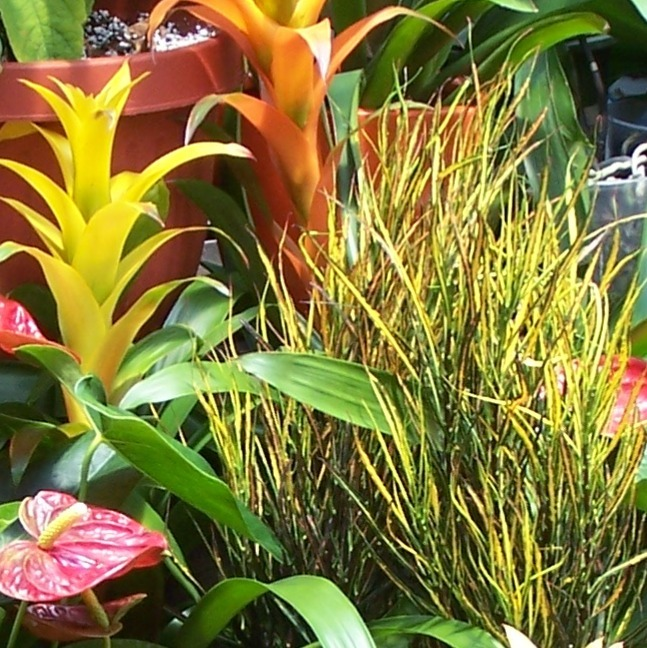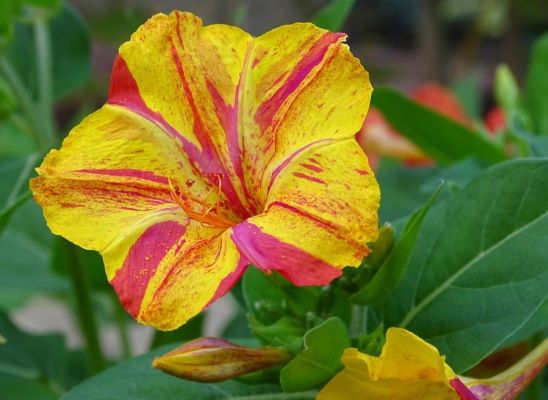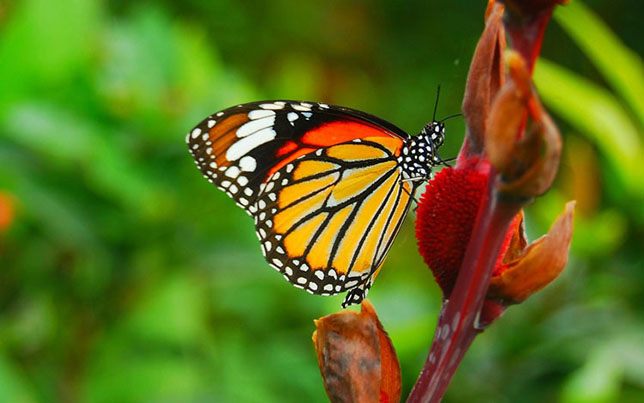Ok, I admit it. I have a love-hate relationship with the spike. Yes, sometimes it's just the thing you need to perfect that design. They're easy to grow, easy to find, and blend well with almost everything. But ugh, it's like building one more Starbucks on the block--yes, maybe it's good, but ubiquitous. If you've ever looked at your spike plant with less than fervent adoration, perhaps our suggestions below might stir you.

Plants to Use Instead of Spikes
Do I Really Need a Spike Plant at All?
Maybe the first thing to ask is if you really NEED that spike. Ever since the "thriller, filler, spiller" container garden marketing concept was foisted on the buying public, it almost seems like it's become law rather than just a how-to suggestion (that not so coincidentally makes folks buy more plants). It has led to the proliferation of red geranium, vinca vine, and spike-filled window boxes and the necessity for some tall, narrow, upright plant (guess which one) to be plunked dead center into every bowl of petunias or basket of begonias.
There are many more ways to combine plants, including ones that actually take into consideration the size and shape of the planter, among other things. So, while being a savvy sales strategy and admittedly a considerable help to newbie gardeners, the "T-F-S" plan in my mind is merely an option, not the only route to container garden success. For some I realize that's a bit radical, so we'll start here with some suggestions for alternatives to that spike plant that will take your container garden combos up a notch.

1. Cyperus papyrus:
- Some plants just naturally get noticed, and King Tut™ is one that tends to stop folks in their tracks. Tall stalks up to 6 feet look as though they're topped with fluffy, feathery green fireworks. Spectacular alone or in a combo, they are perfect architectural accents for modern designs. Prince Tut™ and Baby Tut™ are relatives of shorter stature--you won't have to crane your neck at these! Cyperus is actually a water plant in its native Africa, but it grows equally well in a container with typical annuals such as petunias. It can winter in a bright spot indoors in a pot with 1-2 inches of standing water--I just put mine in a pot without a drainage hole and it does wonderfully. It looks so nice as a house plant I almost hate to take it back outside!
2. Phormium :
- One of the first professional planters I ever did won a contest, and had a striking orangey striped phormium smack in the middle. It was so much fun to play off all the colors in those spiky leaves that I still remember how easily that design came together. Phormium, or New Zealand flax, is just one of many fabulous foliage plants that hail from that region. As you might imagine, they are drought tolerant and most do well in full sun and heat, although some of the pink varieties may tend to sunburn a bit. Evergreen and hardy to about 15-20 degrees, they may overwinter in your containers with a little protection, depending on your climate. Spiky, upright, sword-like leaves may be solid or striped in shades of orange, pink, yellow, cream, purple, bronze, or green. Most grow to between 3 and 6 feet, but there are a few that will be 2 feet or less that would suit smaller containers. They are generally deer resistant, and the flowers, while not that attractive to you and me, do attract hummingbirds. Don't plant too deep or mulch closely, and make sure your soil is well-drained. The only drawback is that they're likely to be a lot more expensive than that spike. If you're in cold winter zone, place them in a sunny window indoors and keep them barely moist, and you'll have them for next year. And it will be worth it, I promise!
3. Lemon Grass:
Why not add a thriller to your culinary creations as well? If you're into Thai, Vietnamese or Indonesian cuisine, or want a relaxing cup of tea, lemon grass is just the thing. Lemony with floral notes and a hint of ginger, add to your stir-fries, soups, marinades, or curries. The thickened stalk--the bottom 4 or 5 inches of the plant--is the most flavorful part, but the remainder can be used to impart a little extra flavor. Cut off only the stalks you need, and new stalks will appear. Growing vigorously to 3-6 feet, it should be kept moist when the weather turns hot. And guess what else? Like other citrus-scented plants, it repels mosquitoes! Deer don't like it either, so what more could you want? Perennial in zones 8 and warmer, this one's a real winner.
4. Schizachyrium scoparium:
- I'm not suggesting you pronounce it, just plant it! This native grass, also called little bluestem, is a heavenly blend of steely blue with green, pink, and purple tones that intensify in fall. The airy texture makes a great contrast with large-leaved plants like sweet potato vine and geraniums, and the gentle hues shine paired with silvers, pinks, blues, and purples. Most varieties will mature at 3-4 feet, but a container will restrict their size somewhat. Heat, humidity, drought tolerance and deer resistance add to their appeal. Some varieties tend to flop; growing in full sun will help prevent that problem. Hardy in zones 3-9.
5. Ruellia 'Purple Showers':
- This tropical plant is common in Florida*, but gardeners in colder climes may find this a new summer treat that can also be grown as a houseplant in a sunny window. Non-branching, bronzy-green stems with dark green, narrow foliage reach 3-4 feet. The common name, Mexican petunia, refers to the bluish-purple trumpet shaped flowers that attract hummingbirds and butterflies. Each flower lasts only one day, but bloom in such profusion that you'll never notice. They require a regularly moist soil, so don't let them dry out. If they get leggy, just cut them back to encourage new stems. Self-cleaning with great heat tolerance, "Purple Showers" makes a bold statement partnered with chartreuse coleus, yellow hibiscus, red verbena, and sweet potato vines. Hardy up to zone 8, and a little above in a sheltered spot. *Note that this is considered invasive in Florida, as it may spread by rhizomes in moist areas and crowd out native plants. It does not seed, however.
6. Cordylines:
- Here I’m referring to Cordyline fruticosa, commonly known as “Ti” plant, not Cordyline australis, which still looks like a spike (but at least is being bred now in pinks and yellows). Ti plant boasts large, wide, pointed glossy leaves, often striped, in shades and mixtures of pink, burgundy, purple to almost black, orange, peach, yellow, cream and/or green. They can eventually grow to 10 feet, but 3-4 feet is more likely in a season for a containerized plant. For smaller containers, start with a plant in a 6 inch pot. They do not branch, so stems will grow straight up.
A hardy evergreen in zones 10-12, in colder zones they can be overwintered indoors in bright indirect light. (Always make sure to properly transition your plants from indoors to outdoors and vice versa). They grow well at 55 to 95 degrees, and enjoy a humid environment. Depending on variety, they can grow in full sun to heavy shade, but most are at their best in morning sun, all-day filtered sun, or bright shade. Take note of where they are merchandised when you purchase—if they are shaded you will need to acclimate gently to full sun. Leaves may lose their vibrant coloring in lighting that is too dim. Cordylines prefer a moist, well-drained soil—too dry and the leaf edges may brown, while very wet plants may rot. Don’t use fluoridated water or leaf edge browning may occur.
All that being said, they’re really very easy to grow—the only issue I’ve ever had is an occasional mealybug or aphid breakout, so keep an eye out and treat quickly should you find a pest. Check at leaf joints and under the leaves—if you find a mealybug, apply rubbing alcohol to the insect with a cotton swab. For aphids, spray with an insecticidal soap.
You can create fabulous monochromatic designs with these gorgeous foliage plants. I love the peachy tones of “Morning Sunshine” with Supercal TerraCotta Petchoa (a cross of petunia and calibrachoa), creeping jenny, and burgundy verbena. Or “Red Sister,” with petunia Supertunia® Vista Fuchsia , verbena Superbena® Burgundy, and scaevola Scalora® Topaz Pink. “Candy Cane” is awesome with petunia Supertunia® “Picasso in Pink” and Breathless® Blush euphorbia. If you desire a larger palette, try "Red Sister" with Supertunia® "Royal Velvet", Bandana® Cherry Sunrise lantana, gold bidens and green sweet potato vine.
7. Mahonia 'Soft Caress':
- For those of you familiar with typical mahonia and its spiny, holly-like leaves, this will come as a big surprise if you haven't seen this plant yet. Looking more like a small palm, the only aesthetic feature "Soft Caress" shares with its shade-loving cousin is the lovely fragrant yellow flower spikes. This one tops out at about 3 feet, and is an elegant centerpiece in a shade container. Surround it with any flowering shade annual you like--impatiens, begonia, torenia, or make an impact with the colorful foliage of heuchera, hosta, and trailing coleus. If you're in zone 7 northward, this mahonia should be treated as temporary in an outdoor pot, but should overwinter in a bright spot inside just fine.
8. Snake Plant:
- Sansevieria, or snake plant, has an extremely upright habit with long pointed leaves, and many different patterns of variegation to choose from, in green/white or green/yellow. Despite its famed drought tolerance and dislike of overly wet soils, it fares quite well mixed with New Guinea impatiens, ferns, and torenia, which I never would have believed had I not seen it myself. And in Florida they are often found near the beach, growing in blazing sun in the sand, subject to inundation by the tides. Granted, they don't look beautiful, but they live. For drier soils, mix with heuchera, begonias, and lamium. Snake plants can be grown in full sun as well, but you must take care to transition them slowly to avoid sun damage. My favorite varieties include "Bantel’s Sensation" - narrow leaves with heavy white longitudinal streaking, and “Moonshine," with wider, very silvery leaves. Both look fantastic in part shade with white New Guinea Impatiens and white torenia. Another favorite, "Black and Gold", lights up the shade combined with yellow tuberous begonias and lamium “Golden Anniversary.”
9. Dracaena cultivars:
These are most often sold as houseplants, and are commonly called corn plants. The most striking varieties are cultivars of Dracaena demerensis. Dracaena "Limelight" is a solid chartreuse,"Lemon-Lime" has wide bands of chartreuse and dark green with a slim white striping, and "Whitney" is streaked green and white. Any of these, or one of their variably sized cousins, will thrive in bright shade outdoors, making a magnificent statement as the centerpiece of your design. And they're easy to overwinter indoors, so hopefully you can reuse year after year.
10. Juncus spp.:
- Juncus species are rushes, grassy-looking plants most often found in boggy areas. Some are compatible with most other garden plants and make excellent container garden specimens. 'Blue Arrows' (zones 4-9, 3-4 feet high) and 'Blue Mohawk' (zones 5-9, 2-3' high) are the most popular in commerce, with blue-green very narrow foliage and a stiff, upright habit forming a clump about 12" wide. They will last long into the fall before finally dying back for winter.
More spike plant substitutions to consider:
- Other plants to add height and structure to a shade planting are Strelitzia (bird-of-paradise), Spathiphyllum (peace lily), and bamboo palm. Keep in mind that dracaena, snake plant, peace lily, and bamboo palm are among the best indoor air-cleaning plants. Once transitioned to indoor living, you'll get an added benefit from these long after summer container season is over. Cannas, hedychium (butterfly gingers), and zingiber (ginger) species will lend tropical flair to large containers.
- Perennials with spiky upright appeal include liatris, guara, iris, dianella, pardancanda (candy lily), belamcanda (blackberry lily), and crocosmia. These will give you not only fabulous foliage, but added flower power, and if they are hardy a couple zones above yours they will likely return in your container. Otherwise, set your pot in a protected place for winter, perhaps wrapping with a bit of burlap to keep the roots warmer.
- Grasses are, of course, a natural for the "thriller" role. Almost as commonly used as the spike is red fountain grass, Pennisetum rubrum, a striking plant (even if overused), especially in late summer when the foxtail "flowers" fluff out atop the graceful stems. I cannot tell you how many customers I disappointed during my garden center years, informing each one with that plant in their cart that it was NOT perennial in our zone. It was a surprise to at least 75% of them. If that doesn't bother you, then you might also like pennisetum 'Fireworks,' that starts the season mostly white and light pink, deepening to hot pink tones in full sun later in the season--this variety is a bit smaller growing. Despite tremendous breeding efforts, I don't think there is yet a grass that color hardy to zone 7 or above, although some panicum cultivars like 'Hot Rod' and 'Cheyenne Sky' are getting closer. Panicum cultivars of our native switchgrass are excellent possibilites for containers as their habit is strongly upright. Other vertical grasses include andropogon species and calamagrostis (feather reed grass). Calamagrostis 'Overdam' and 'Lighting Strike' offer fresh green and white striped foliage that almost sparkles in the sun.
- Vining plants grown on a small trellis or obelisk can be the most "thrilling" of all. Mandevilla will send forth hummingbird attracting trumpets of white, red, or pink all summer long. Thunbergia, black-eyed Susan vine, is a charmer with its dark-centered yellow, white, or orange flowers. You can plant a compact clematis or grow a cardinal vine from seed--there are so many fun plants to try! Just choose a plant that's appropriate for the size of your support and container--you may need to do a little pinching and pruning to keep the balance right in your container.
In conclusion, if you're looking for something new and different to bring a little drama to your next container garden, head to the houseplant, perennial, or even the shrub department, and see what's on offer. And if you don't need to be "thrilled" by a spiky thing in your container garden, then be thrilled with whatever you choose. As long as the plants live long enough for you to enjoy them, there's no rules!!

























